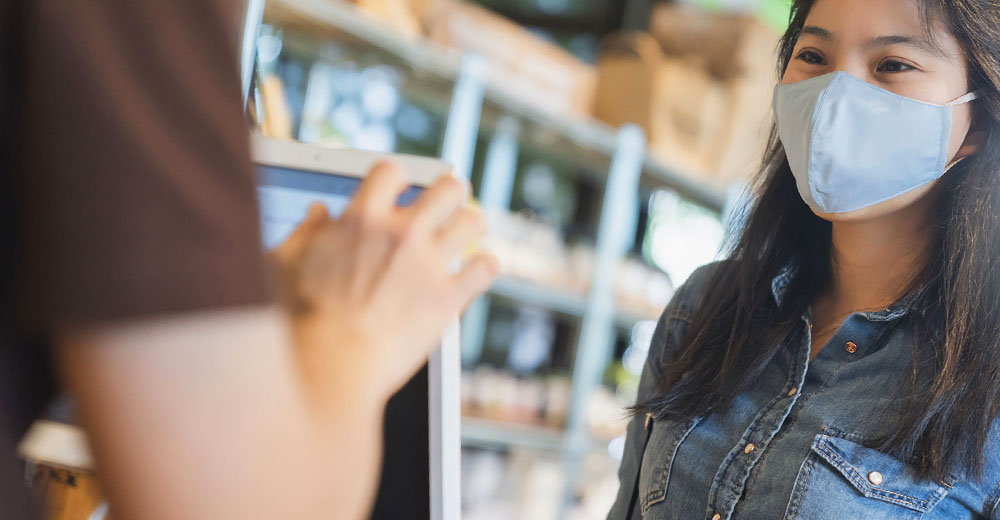The COVID-19 pandemic will be one of the defining events of our lifetime. The economic consequences will last years and forever change consumer behavior.
Over the last 30 years, experts have been studying the slow burn of consumer adoption of new technologies. Never have we witnessed the adoption rate of new tech accelerate to the degree we saw in the last 60 days in e-commerce and video-conferencing.
Though e-commerce has been developing since the early 2000s and was tracking with a hockey stick growth pattern, 80 percent of products were sold through retail stores compared to 20 percent online prior to the pandemic.
Today, everything we thought we knew about retail and how it compares to — and most importantly competes with — e-commerce needs to be revisited. The pandemic, with all its destruction, has provided the opportune time to turn a new page and finally figure out how to converge offline and online retail to come out as winners.
This discussion will exclude the unprecedented sales growth in obvious sectors like groceries and essentials during the pandemic, and focus instead on the other end of the consumer spending spectrum — the fashion industry.
A Bit of History
It used to be simple. Manufacturers (brands) were responsible for manufacturing goods, and retailers were responsible for selling them to consumers. This standardized supply chain began to alter as brands figured out that the direct-to-consumer (DTC) model brings better margins, along with control of the brand message and direct feedback from consumers. DTC Web stores (e-commerce) accelerated this movement even further.
Additionally, a new breed of digitally native brands emerged to sell exclusively online. However, many of them recently added branded retail stores. Sooooo, clear as mud, right? We’re seeing a big mix of different ways to sell, but all have a common goal: to understand the customer and to drive higher lifetime value (LTV), achieve higher dollar value from each order (AOV), and to maximize the conversion rate (CRO). In short, happy customers mean a happy brand.
Luxury retailers went online to keep up with the evolution, despite the fact that it was practically impossible to recreate the high-touch experience they offered in stores. Sophisticated websites with smart searches, beautiful imagery with 360-views, artificial intelligence chatbots — all the bells and whistles could not replace the human-to-human connection that builds a relationship between the consumer and the brand.
The inability to service the remote shopper properly was an ongoing pain that became much more apparent with store closures due to COVID-19.
The Evolution of Commerce
Regardless of the business model a brand chooses, one thing is certain: Faceless/transactional relationships with customers are no longer enough. Both brands and consumers want deeper, more meaningful connections. Brands need to hear directly from their customers to be agile, and consumers are eager to give feedback and be heard. The relationship between the two is more bound than ever before. The brands that don’t understand its importance will struggle to survive.
There is a tremendous economic benefit to running an online store. With no rent or utilities to pay and fewer people to support, it drives higher profit margins. Would you be surprised to learn that a 2 percent conversion rate for an online store is considered good in comparison to 30 percent in retail? Most online fashion outlets convert around 1 percent, which means they must advertise the site to 100 visitors to get a single order. That’s expensive and inefficient.
Branded retail stores, although very expensive to set up and keep up, can be very profitable if they manage to get walk-in traffic. However, that retail traffic comes in waves, generating a ton of downtime for sales associates and diminishing the ROI per square foot. Retailers that win today are the ones that build personal customer experiences, transform their online presence, and converge the online and offline experiences.
What if we could blur the line between online and offline? What if we could connect the professionally trained sales associate with customers browsing aimlessly through dozens of pages, all alone and without any help? What if there were an easy way to get them into an interactive two-way shoppable video session? Whoa! Mind-blowing, right? Not anymore.
Progressive brands have implemented virtual personal shopping using FaceTime or Zoom. Customers can access live shoppable makeup tutorials. Some brands are connecting remote shoppers with sales associates via an integrated platform.
This live shopping technology just became available in the U.S., and if not for COVID-19, it probably would take another year for most brands to start paying attention to the growing demand for personal interactions while shopping online.
The two business sectors that have accelerated the most during the pandemic are e-commerce related tech and video-collaboration tech. The next logical step is the convergence of both: live video commerce, or simply live commerce.
Live Commerce
Store closings completely paralyzed the fashion industry. Retailers have been in complete disarray with no precedent and very little guidance on how to survive this economic apocalypse. Most sales associates have been furloughed. The primary human-to-human link between the brand and its customers has vanished.
Thankfully, we live in a technologically advanced era, and technology can help restore the missing human-to-human experience.
Live commerce means that the consumer and the associate are not in the same proximity and video technology assists the customer in making a purchase. There are two flavors of live commerce: one-on-one and one-to-many.
The one-on-one experience involves two parties getting on a two-way video call and using various tools to “co-shop.” The tool can be as rudimentary as FaceTime, with the two parties discussing an item and the salesperson using the camera to show the product.
A more advanced solution allows the two parties to co-shop using integrated systems that let them browse together, giving customers the ability to review recommendations in real time. This type of interaction can be initiated by a customer while browsing through the brand’s site, or by an associate sending a dedicated direct link, which the customer can use to connect in a two-way shoppable video later. The benefit of this service is that it allows the associate to spend dedicated time with the customer. It creates a personal connection that previously was not possible online.
The other flavor of live commerce is one-to-many, or a shoppable livestream. This type of experience enables retailers to conduct QVC-like video commerce directly from their websites. This is a great tool to host a trunk show, or to stream editorial content. These are great ways to communicate and connect with many customers at once.
Since this method uses video streaming, the host can see questions from all viewers in live chat and answer them as they come up. The big difference between the social live stream and live commerce is that the latter is fully shoppable, enabling customers to have the watch-and-buy experience.
This is a win/win/win. The consumer receives a personal shopping experience they previously was possible only get in person. The sales associate gets a tool to sell outside the store walls, earning more commissions and creating long-lasting relationships. The brand gets happier customers, happier employees, higher conversions, an uplift in AOV, higher ROI per square foot, and lower returns. This is the real omnichannel experience all brands want to achieve.
The Challenge
Digital technology alters the balance of power between customers and brands. While customers gain the power of choice, digital technology dramatically improves the economics of the business.
The biggest challenge is not technical, though — it is cultural. The culture has to change at the top to drive a single-focused organization. “Omnichannel” became a buzzword, but most brands run a separate profit and loss statement between the e-commerce and physical stores. The sales and all the associated expenses are tracked in two uncrossing parallels. The team is rewarded based on the success of the parallel they are part of. That means a sale is NOT a sale. In the world of live commerce, which team will claim the sale?
How can any brand achieve the omnichannel experience when internal teams, profits, expenses and commissions are so divided? Live commerce intuitively propels collaboration between all the departments in the organization, but it’s up to the management to ensure that all parties involved are compensated appropriately.
The New Normal
The pandemic has altered consumer behaviors. Everyone is looking for a new normal and new tools to survive.
“Seventy-five percent of Gen Xers have shopped online for nonfood products in the past two weeks, and of those more than 40 percent are shopping more in the wake of the COVID-19 pandemic,” noted McKinsey authors Jenny Child, Rod Farmer, Thomas Rdiger Smith, and Joseph Tesvic last month.
While we look forward to a time when businesses can return to pre-COVID-19 revenue, retailers and brands absolutely must ramp up operations to accommodate consumers remotely.














































Social Media
See all Social Media